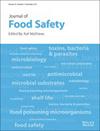EVALUATION OF THE TECRA™ VISUAL IMMUNOASSAY FOR DETECTING STAPHYLOCOCCUS AUREUS IN COSMETIC/PHARMACEUTICAL RAW MATERIALS AND FINISHED PRODUCTS
Journal of Rapid Methods and Automation in Microbiology
Pub Date : 2011-11-09
DOI:10.1111/j.1745-4581.1999.tb00389.x
引用次数: 6
Abstract
Abstract An assessment of the new TECRA™ Staphylococcus aureus Visual Immunoassay (VIA) was conducted to detect the presence of Staphylococcus aureus in cosmetic/pharmaceutical raw materials and finished products. Samples were inoculated with pure cultures of Staphylococcus aureus. In addition, a mixed bacterial inoculum of Staphylococcus aureus, Staphylococcus epidermidis, Escherichia coli, and Pseudomonas aeruginosa was used to inoculate samples of raw materials and finished products. After a 24 h incubation period at 35C, each enrichment broth was analyzed for the presence of Staphylococcus aureus by the standard conventional method and the TECRA™ VIA. The following preenrichment broths were analyzed: the TECRA™ Staphylococcus Growth Medium, a modified version of the TECRA™ Staphylococcus Growth Medium with 4% Tween 20. Tryptic Soy Broth (TSB), and TSB with 4% Tween 20. Uninoculated enrichment broth samples were used as negative test controls. There was a 100% correlation between the visual immunoassay and the standard method in both pure and mixed culture studies for the detection of Staphylococcus aureus in preenrichment samples of the modified TECRA™ Staphylococcus Growth Medium and TSB. However, the TECRA™ VIA detected Staphylococcus aureus in 26 h while standard USP detection method required 4–5 days to be completed. These test results indicate that the TECRA™ Staphylococcus aureus VIA is equivalent to the conventional method for detecting the presence of Staphylococcus aureus contamination in cosmetic/pharmaceutical finished products and raw materials, but in a considerably shorter period of time. Furthermore, the TECRA™ Staphylococcus aureus VIA provides a user-friendly alternative to the standard conventional method for the detection of Staphylococcus aureus contamination.用于检测化妆品/制药原料和成品中金黄色葡萄球菌的tecra™视觉免疫分析法的评价
摘要:对新型TECRA™金黄色葡萄球菌视觉免疫分析法(VIA)进行了评估,以检测化妆品/制药原料和成品中金黄色葡萄球菌的存在。样品用金黄色葡萄球菌纯培养物接种。此外,采用金黄色葡萄球菌、表皮葡萄球菌、大肠杆菌和铜绿假单胞菌混合菌接种原料和成品样品。在35C条件下孵育24 h后,采用标准常规方法和TECRA™VIA分析每个富集肉汤中金黄色葡萄球菌的存在。对以下预富集培养基进行分析:TECRA™葡萄球菌生长培养基,TECRA™葡萄球菌生长培养基的改良版本,添加4%的吐温20。色氨酸豆汤(TSB)和含4% t20的TSB。未接种的浓缩肉汤样品作为阴性对照。在改良的TECRA™葡萄球菌生长培养基和TSB预富集样品中检测金黄色葡萄球菌的纯培养和混合培养研究中,视觉免疫分析与标准方法之间的相关性为100%。然而,TECRA™VIA在26小时内检测到金黄色葡萄球菌,而标准USP检测方法需要4-5天完成。这些检测结果表明,TECRA™金黄色葡萄球菌VIA与检测化妆品/制药成品和原料中金黄色葡萄球菌污染的传统方法相当,但时间要短得多。此外,TECRA™金黄色葡萄球菌VIA为检测金黄色葡萄球菌污染的标准传统方法提供了一种用户友好的替代方法。
本文章由计算机程序翻译,如有差异,请以英文原文为准。
求助全文
约1分钟内获得全文
求助全文

 求助内容:
求助内容: 应助结果提醒方式:
应助结果提醒方式:


